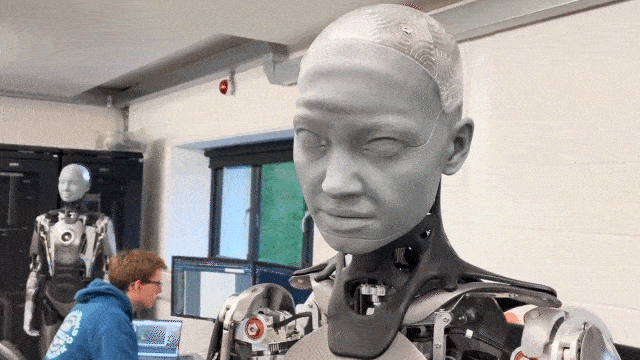Bow down to your AI overlords: How robots progressed in 2021


Ameca from Engineered Arts is eerily human-like. Photo: YouTube
Robots are fun and helpful, aren’t they? Their abilities become more refined each year.
The human-looking robots aren’t so clunky any more, but what does it mean that the most agile of these – able to chase us down back alleys on foot – tend not to have faces? Just like the murderous bi-peds from the Robocop movies.
The fact is, we have mixed feelings about what kind of faces we prefer to see on robots.
A 2013 study found that when given the choice – between robots with a human appearance, a mix of human and robotic appearance, or a strictly robotic appearance – 60 per cent of older adults want robots with human faces, and only 6 per cent want ones that have a mixed human-robot appearance.
University-aged adults preferred robotic-looking faces, though they were open to the other two choices.
However, older and younger people agreed that “they would prefer mechanical-looking robots for personal-care tasks such as bathing, a preference based on privacy concerns”, according to a report at machinedesign.com.
And now?
Eight years later, the faces of humanoid robots have become much more expressive.
And we’re not entirely comfortable with that.
“It’s always a bit chilling when you come across a robot that’s able to express itself so much like a human being that it almost tricks the brain into thinking it’s possessed by a human spirit,” mused Victor Tangermann, staff writer at Futurism.
“That’s more or less what a UK-based robotics company called Engineered Arts managed to pull off with its humanoid robot Ameca.”
When the company posted a video of Ameca to YouTube in July, the comments section was rich with disquiet.
Even Elon Musk had something to say about it: “Yikes.”
The perching bird
Elsewhere, Stanford engineers have created a robot that can perch and carry objects like a bird.
Basically, it’s a quadcopter drone with bird-like legs and claws modelled on those of the peregrine falcon.
In place of bones, “it has a 3D-printed structure – which took 20 iterations to perfect – and motors and fishing line stand-in for muscles and tendons”.
The researchers say the robot has “an especially strong and high-speed clutch that can be triggered to close in 20 milliseconds”.
Once the claws are wrapped around a branch, the ankles lock and an accelerometer on the right foot reports that the robot has landed and triggers a balancing algorithm to stabilise it.
The researchers say the perching bird could be useful in search and rescue operations, or for accessing and studying hard-to-reach microcosms, namely the mysterious hearts of trees.
Robots that can make babies
According to a statement from the University of Vermont, scientists have discovered a new form of biological reproduction – and created self-replicating living robots.
Made from frog cells, these computer-designed organisms gather single cells inside a Pac-Man-shaped ‘mouth’– and release Xenobot ‘babies’ that look and move like themselves.
Then the offspring go and do the same, over and over.
Read our report from last year about the rise of the Xenobots.
Well, the Xenobots are now having babies.
The scientists say these self-replicating quasi-creatures could open up a new pathway for regenerative medicine.
Sure, or they could breed like rabbits and take over the world.
AI detects social distancing breaches
Griffith University researchers have developed “an AI video surveillance system to detect social distancing breaches in an airport without compromising privacy”.
By keeping image processing contained to a local network of cameras, the team bypassed the problem of storing sensitive data on a central system.
The researchers trialled the technology at “an airport” that pre-COVID-19 had 6.5 million passengers annually with 17,000 passengers onsite daily.
Hundreds of cameras covered 290,000 square metres with hundreds of shops and more than 40 check-in points.
That’s the discreet way of doing it.
Computer scientists from the University of Maryland invented a robot that can detect when people are breaching social distance rules.
In a trial, the robot was able to spot two or more people standing within 1.8 metres (six feet) of each other.
It then approached the offenders, and quietly let them know they were standing too close together.
It does so by flashing an on-screen message, which is deemed to be more discreet and sensitive than talking.
The robot also features a thermal camera “that can help detect someone hotter than others who might have a fever”.
The robot can then notify health or security personnel.
Robotic interpretive dance
The engineers at the heart of US company Boston Dynamics have been working for more than 35 years to create robots that can get around on legs.
Once they were clunky, even comical. But now they’re heading toward something like elegance.
If you hate interpretive dance, here’s a chance to be afraid of it, too.
What’s for dinner, mum?
UK company Moley Robotics has launched the “world’s first fully robotic kitchen”.
The company boasts that you will “enjoy international cuisine any time, control calories and get cooking tips and recipes from chefs around the world”.
The kitchen tells you “when ingredients need replacing, suggests dishes based on the items you have in stock, learns what you like and even cleans up surfaces after itself”.
It’s pretty neat, but the rice and pasta dishes in the video look a little messy, which suggests high dining is a work in progress.
But, of course, if the robot says “eat your dinner”… you better eat your dinner.
Stay out of trouble
Aw… cute! A robot dog. Wait a minute. Is that a 10-shot sniper’s rifle where his face ought to be?
This little beauty was developed by Ghost Robotics out of Philadelphia.
The company showed off its killer robo-dog in October, at the Association of the United States Army’s annual convention in Washington DC.
It can engage with targets from more than a kilometre away.
But don’t stress: The dog needs human permission to take a shot.
Think you can outrun the law?
This is Atlas, also from Boston Dynamics.
The idea of making a run for it just got trickier.
Comments at the company’s YouTube page range from awe to bordering on terror.
User ‘Trevor Bennett’ wrote: “There’s a moment just after it vaults over the rail … when it jumps up onto the box, it has a brief but eerily human loss of balance, but quickly corrects itself. Amazing.”
‘SpeedyCorky’ observed: “Absolutely impressive, while getting really close to completely terrifying.”
‘2020sucks’ goes all apocalyptic: “Thank you for the continued documentation of the terminators. I’m sure this will be helpful in the future.”








